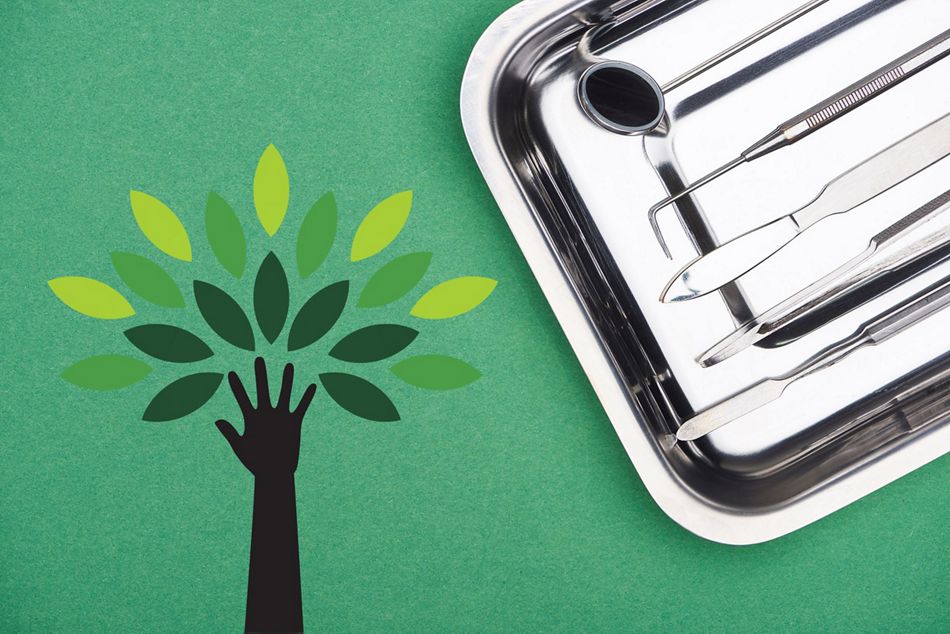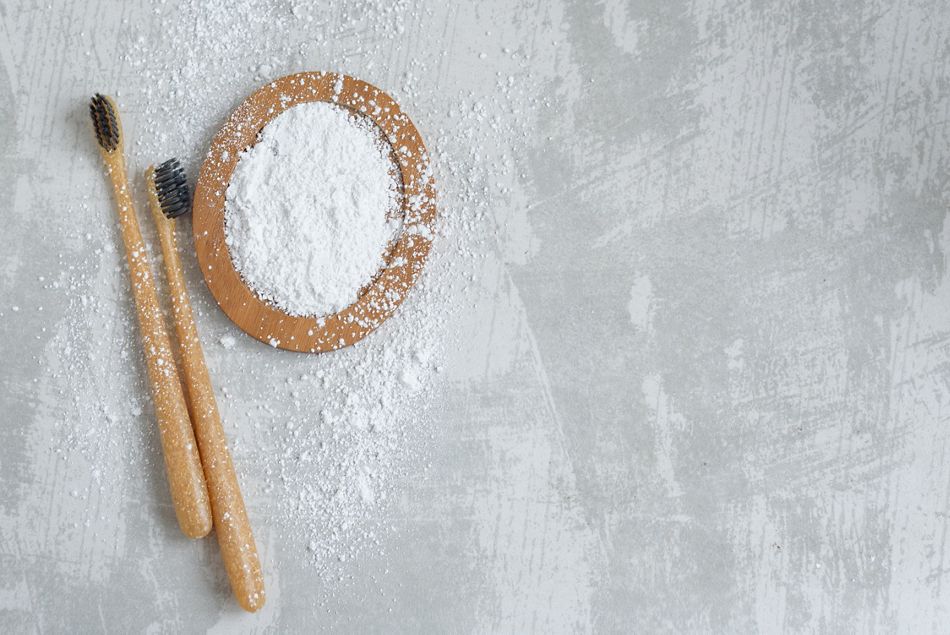
If COP26 highlighted one thing, it’s the fact that it falls to all of us as individuals to combat climate change. And that includes what we do in each of our dental practices. In fact, just in England research into NHS primary dental care estimated that each year, the NHS dental service is responsible for 675 kilotonnes of carbon dioxide equivalents (CO2e). Imagine what this number would be if it included all dental practices around the world.
It’s clear that dental teams can do more. But beyond adorning the practice with a kaleidoscopic panoply of plastic bins for various materials and fastidiously classifying our cardboard, cans, and apple cores, what more can dental practices do to play their part?
There are a few key angles to consider as we start thinking about sustainability:
- Human factors and behavioural changes
- Sourcing and purchasing more sustainably
- End of life processes for materials and tools
- Evaluation and monitoring
We’ll look at five tangible ways that you can make a difference in these areas:
1. Change behaviours
Many of the changes that we can make are behavioural. These issues might be simple to fix, but old habits can die hard, and inertia around ‘the way we’ve always done things’ is not uncommon. But it’s worth examining because there are gains to be made for the practice as well as for the environment.
The study referenced above found, for example, that 64.5% of emissions from NHS dental services related to travel (staff and patient). Using digital dentistry and online dental services creatively to replace patient travel—or rewarding patients who take public transportation (or walk or cycle) to your dental clinic—are simple ways to switch things up. Even on a small scale, changes like these can accumulate over time to make a big difference.
The same information we no doubt had drilled into us as children still holds true too: turn lights off when we leave empty rooms, shut computers down when we clock-off for the evening, turn screens off when they’re not being used, conserve water where possible and yes—reduce, reuse, and recycle. You may also choose to remove TVs from patient waiting rooms—let’s be honest most are probably glued to their phones anyway. (All the more reason to think about your TikTok and Instagram presence!)

Equally, while many of us are used to paper-based processes, there are increasing opportunities to cut waste—and make efficiency gains at the same time—by switching to digital processes. And it’s not just paper. Switching from film radiography to digital imaging once again offers process and efficiency gains while simultaneously eliminating the need for the chemicals used in the development of film, some of which can be harmful for the environment if disposed of improperly.
While equipping a dental practice with new digital imaging comes with an upfront cost, it’s likely to pay for itself pretty quickly. In fact, the eco-dentistry association estimates that switching from paper and film to digital processes to save practices on average $8,769 per year.
Up-front costs in making these switches can often be offset against cost savings
2. Choose greener procurement
Another area that can make a considerable difference to your dental office’s sustainability credentials is switching to green energy-efficient products. This could be as simple as swapping lightbulbs for a more energy efficient option, fitting infrared sensors so that lights are automatically turned off when a room is not in use, or fitting water-saving toilets or appliances. Once again, up-front costs in making these switches can often be offset against cost savings.
Since chemicals in traditional paints contribute to air pollution and can have an adverse effect on health and air quality long after they’ve dried, you might wish to consider non-VOC (Volatile Organic Compound) paints when redecorating. Similarly, many cleaning products can impact air quality or cause health issues, but many of these can now be easily swapped for less toxic versions.
Single-use items may also be neutralising your eco-dentistry efforts. From glass irrigation syringes to stainless steel suction tips, reusable products can drastically reduce the dental waste you’re producing day-to-day. Realistically, eradicating single-use items altogether is unlikely to be possible yet, but it is usually possible to
People respond less well to nagging than they do to a grand vision
3. Educate your dental team and patients
As the expert on your patients’ dental health, you can also help to guide them towards more sustainable self-care. For the sustainability enthusiasts, bamboo toothbrushes and floss picks are becoming increasingly easy to get hold of, along with novel products such as toothpaste capsules which eliminate the need for plastic tubes. But even for those patients who continue to use more common products, a reminder that used toothbrushes/electric toothbrush heads could be recycled rather than binned can also nudge them in the right direction. And of course, prompting each of your patients to turn the tap off when they brush and to think about water conservation can help your sustainability efforts ripple much more widely. Pun 100% intended.
When it comes to getting dental team on board, one of the most important factors is ownership. People respond less well to nagging than they do to a grand vision. Help colleagues to buy in to the goal of running a more sustainable dental practice and to see how their contributions can help. It’s important to remember that with climate change a lot of little actions have added up to a very big problem. Conversely, a lot of small actions can snowball into remarkably pronounced improvement
Staff who share your vision for sustainable dentistry will be more energetic in helping you to achieve your goals. They will also bring more creativity to the problem and perhaps offer their own suggestions for where improvements could be made. Sustainability is one area where—whisper it—the novice could know more than the master. Open up to their suggestions and let yourself be led. There are few things more rewarding than watching your pilot project as it’s picked up, taking on a life of its own and galvanizing the whole workforce.

People are unlikely to go too far out of their way to do the right thing
4. Optimise the layout of your dental practice
It’s been said that you only find out who your true friends when you need someone to help you move house. Certainly, humping furniture around is seldom undertaken without good reason. But rethinking the layout of your dental practice can result in sustainability gains even in this area where inertia so often reigns supreme.
By making the most of natural light you can reduce your reliance on electric lighting, as well as making a more pleasant place to work and to visit. Natural ventilation can be harnessed too to limit reliance on air conditioning or electric fans, simply by a well-considered room arrangement.
But aside from light and air, it’s also worth thinking about how to nudge patients and staff to make greener decisions. It’s a bit of an indictment on human nature but the reality is that people are unlikely to go too far out of their way to do the right thing. If the general waste bin is two paces away while the plastic recycling bin is up a flight of stairs, I’m afraid recyclable plastic is going to end up in that general waste bin, because it’s right there.
In their highly influential 2009 book ‘Nudge’, Richard Thaler and Cass Sunstein coined the term ‘choice architecture’. Simply put, this means presenting a choice in such a way that a desirable behaviour is more readily chosen. With effective choice architecture, you can encourage positive behaviours without anybody even noticing that they’re being ‘nudged’. For example, think about where plastic waste is most likely to be generated and plan to have plastic bins close at hand. If you’re using a printer or photocopier, have paper recycling points next to them. By anticipating how spaces will be used, you can begin to make recycling and responsible waste management more likely.
Chart your progress over time and communicate the wins to your staff and patients
5. Continuously monitor your progress
The first step on any journey is knowing where you’re starting from. Then you can see how far you have to go, but in future you can also look back and see how far you’ve come. Take a dispassionate look at your practice, conduct a sort of sustainability audit and record some key metrics. How much dental waste are you generating? What percentage of your waste is being recycled? How much paper are you getting through? How much water and electricity are you using?
With these metrics in mind, you can begin to institute the other measures and see how they move the needle. Chart your progress over time and communicate the wins to your staff and patients. Seeing tangible evidence of change can be a hugely motivating force, so use your progress to spur you on to go further. Equally, it can help you to notice where habits are starting to slip, and you can take corrective action to get back on track.
Remember to keep measuring and revisiting these metrics. But remember too that this is a journey. Incremental improvements can amount to big changes over the longer term, and it’s impossible to do everything all at once. But the motivation to take the next step can be much easier to muster when you see the steps you took earlier starting to pay off.
Sustainable dentistry one step at a time
There are a lot of reasons why dental practices face unique sustainability challenges. The nature of the work means high energy and water usage. Medical and dental waste products have all too often been single-use plastics. But there are steps we can take to make improvements and the climate crisis demands a concerted effort from all of us.
Final Thoughts
We’re all aware that sustainability is a marathon rather than a sprint, so think about instituting the following 6 step process to ensure your practice keeps moving forward:
- Gather the data that enables you to assess performance accurately
- Identify possible areas for improvement
- Research how you could do better in these areas
- Make the change
- Evaluate—Did it deliver any improvement? Can this change be sustained over the long term?
- Rinse and repeat!
Now more than ever, there are countless ways to limit and mitigate the harm done to the environment as we go about our work. Hopefully the suggestions above help you to identify new avenues to further transform your establishment into an eco-dentistry practice.
Further Reading:
Want to learn more about how you can make your dental practice more sustainable? Check out these articles:

Want to stay up to date?
youTooth.com is THE PLACE TO BE IN DENTISTRY – subscribe now and receive our monthly newsletter on top hot topics from the world of modern dentistry.